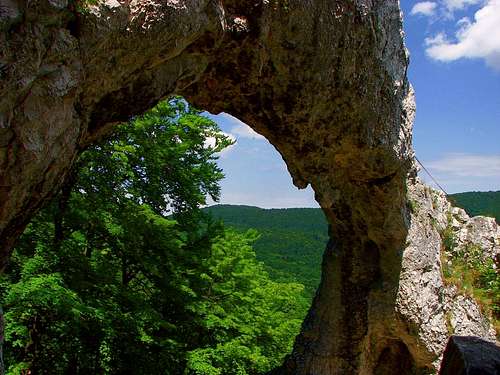|
|
Mountain/Rock |
|---|---|
|
|
47.70352°N / 18.88447°E |
|
|
Hiking, Trad Climbing, Toprope |
|
|
Spring, Summer, Fall, Winter |
|
|
1837 ft / 560 m |
|
|
Vaskapu
Vaskapu means Iron Arch. It is the highest arch in Hungary. It is locatedto the North-West of Budapest in the Pilis-hills about 560m above sea level. This area is a part of Duna-Ipoly National Park founded in 1997.
It's a double limestone arch: the upper "gate" is much smaller than the lower one.
There are some climbing routes.
Getting There
Route from the capital: Budapest - Pomáz - PilisszentkeresztYou can leave the car in Pilisszentkereszt. Go on the green marked path to a small valley and turn up to the rocks on the wood steps. There is a spring on the left side at the first part of the path.
When you reached the rocks you can see two arches. The height difference from the valley to the rocks is 250m.
Routes
The width of the bigger arch is 15m and its height is 8m. The is a sidehole at the bottom of this arch. The 10-15m long routes are totally clean you can make it safe with nuts, firends, slings. These difficulty are UIAA IV-VII but you can find VIII difficulty routes in the inner sides of the arches.The most famous is the Ridge-route which is one of the longest ones in Hungary. I don't want to tell you the length because you would laugh on it. :-) The most important thing: it is beautiful and standing on top there is a wonderful view of the entire Pilis-hills.
Zsigmondy Emil
You can find a table for memory of Emil Zsigmondy (11 August 1861 – 6 August 1885) at the bigger arch. He is the most famous mountaineer with Hungarian origins. Many places, mountains are named about him. There are memorial tours to Vaskapu in every years to tribute to the dead Hungarian mountaineers.Weather
www.met.huLinks
utvonalterv.hu (english version)Routing by car, by public transport, by bike and by on foot
turistautak.hu (english version)
Hiking trails, track logs, downloading into mapping GPS units









bendgriz - May 29, 2008 4:30 pm - Hasn't voted
GPS correctionI visited Vaskapu two weeks ago, and when I arrived at the GPS coordinates cited on SummitPost, found myself in a thickly wooded valley, rather than the hillside further west where the twin arches were indeed found, and climbed to much satisfaction. According to my Garmin Forerunner 305, the arches are actually located at N 47" 42.211', E 18" 53.082'. Key way points are that one does not take the main highway out of town, but rather take a left (turning west) INTO the little town toward the well-posted pizza shop. Third right is the next turn (turning north). Follow that road as far north as your car will go, and park on the side of the road. Keep walking up the same path (road turns into a dirt path) until it crests on a hill (as you approach the crest, you'll see a bare outcropping 2/3 of the way up the hill to your left - it appears quite small, but that's your destination). When you reach that crest (you'll know you've gone too far if you hit a small picnic area), take the steepest trail off to the left, and keep following that steep trail up hill until you see a large cairn (pile of rocks). Look left and THERE you fill finally see the wooden steps mentioned in the original directions posted here. At that point you are a STEEP 150m from the Vaskapu arches. Happy (and safe) climbing!